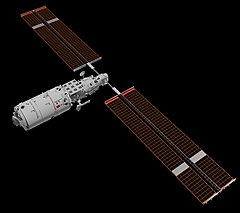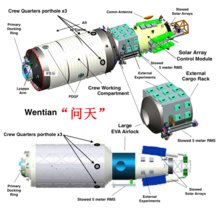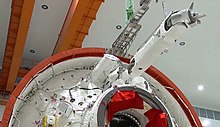 Rendering of Wentian lab module | |
| Module statistics | |
|---|---|
| COSPAR ID | 2022-085A |
| Part of | Tiangong space station |
| Launch date | 24 July 2022, 06:22:32 UTC [1] |
| Launch vehicle | Long March 5B (Y3) |
| Mass |
|
| Length | 17.9 m (59 ft) |
| Diameter | 4.2 m (14 ft) |
| Pressurised volume | 118m3
[3] habitable: 39m3 [3] |
| Docking with Tiangong space station | |
| Docking port | Tianhe Forward |
| Docking date | 24 July 2022, 19:13 UTC [4] |
| Undocking date | 30 September 2022, ~03:44 UTC |
| Time docked | 2 months and 5 days |
| Berthing at
Tiangong space station (Relocation) | |
| Berthing port | Tianhe Starboard |
| Berthing date | 30 September 2022, 04:44 UTC |
| Time berthed | 1 year, 6 months and 16 days |

Wentian ( simplified Chinese: 问天; traditional Chinese: 問天; pinyin: Wèn Tiān; lit. 'Quest for the Heavens [5]'), officially the Wentian laboratory cabin module ( simplified Chinese: 问天实验舱; traditional Chinese: 問天實驗艙), is a major module of the Tiangong space station. It was the first Laboratory Cabin Module launched, and the first module to extend the existing Tianhe core module of the station. It was launched into orbit from the Wenchang Spacecraft Launch Site on 24 July 2022, successfully docking with Tianhe forward port at 19:13 UTC on the same day. [1] [4] On 25 July 2022 at 02:03 UTC, the crew of Shenzhou 14 opened the hatch and entered the module for the first time.
Wentian was later relocated to the starboard port on 30 September 2022 at 04:44 UTC by the indexing robot arm to make way for the Mengtian module [6]
Purpose

The Wentian laboratory module provides additional navigation avionics, propulsion and orientation control as backup functions for the Tianhe Core Module (TCM). It also provides a pressurized environment for researchers to conduct science experiments in freefall or zero gravity which could not be conducted on Earth for more than a few minutes. Experiments can also be placed on the outside of the modules, for exposure to the space environment, cosmic rays, vacuum, and solar winds.
The axial port of Wentian is fitted with rendezvous equipment and first docked to the axial port of Tianhe. A mechanical arm dubbed, as Indexing robotic arm, looking as a sort of Lyappa arm used on the Mir space station moved the module to a starboard port of the TCM on 30 September 2022. [7] It is different from the Lyappa as it works on a different mechanism. Mir's Lyappa arm is needed to control the pitch of the spacecraft and redocking in a different plane, but the Wentian indexing robot arm is used when docking is needed in the same plane. In addition to this arm used for docking relocation, the Chinarm on Tianhe module, could also had been used as a backup of the indexing robot arm. [8] [9]

In addition to this, it also carried a small 5 m (16 ft) long robotic arm like the Chinarm as a supplemental to that arm. It is used for manipulating extravehicular payloads and assisting EVAs. Its positioning accuracy is 5 times better than the Chinarm. Wentian in total has 22 standard adaptors (silver squares) to host the payloads. [10] Wentian's arm is primarily used to transfer experiments and other hardware outside the station. A dual-arm connector is installed on the Chinarm, providing it the capability to link with the 5-meter robotic arm, extending its reach and weight-carrying limits. [11]
Electrical power is provided by two steerable solar power arrays, which use photovoltaic cells to convert sunlight into electricity. With a wingspan of over 55 m (180 ft), each array has an energy collection area of 110 m2 (1184 square ft). [12] The energy is then stored to power the station when it passes into the Earth's shadow. Resupply ships will replenish fuel for LCM 1 for station-keeping, to counter the effects of atmospheric drag.
Aftermath
After launch, the Wentian module was inserted into a low Earth orbit with an average altitude of 393 km (244 mi) at an orbital inclination of 42 degrees, centered in the Earth's thermosphere. [13] [14] It successfully docked with the Tianhe core module nearly thirteen hours after launch. [4]
During the re-entry phase of the Long March rocket's main core stage, NASA Administrator Bill Nelson voiced criticism for allowing the stage to return to the Earth in an uncontrolled re-entry. The stage eventually made re-entry and splashed down over the Pacific Ocean on 30 July 2022, with the bulk of it burning up on re-entry and no known pieces that survived re-entry causing damage. [15]
Assembly
The Shenzhou 14 mission to the space station assisted with setting up the Wentian module in orbit. [16]
Airlock
Wentian has an airlock primarily used for conducting spacewalks. It features more space than the spherical docking hub on Tianhe, which had been used for prior spacewalks. On 1 September 2022 (10:26 UTC) Chen Dong and Liu Yang conducted the first spacewalk from the Wentian airlock. [17] [18] The Wentian airlock is now the primary choice for hosting spacewalks.
Gallery
-
Wentian lab module prior to launch
-
The module relocation process with rotation arm equipped by the Wentian lab cabin module
See also
References
- ^ a b Jones, Andrew (31 May 2022). "Rocket to launch China's next space station module arrives at launch center". SpaceNews. Retrieved 1 June 2022.
- ^ "长五B火箭打赢空间站建造关键之战" (in Simplified Chinese). 新华网. 2022-07-25. Retrieved 2022-07-26.
- ^ a b 朱光辰 (2022). "我国载人航天器总体构型技术发展". 航天器工程. 第31卷 (第6期): 47.
- ^ a b c 杨希 (2022-07-25). "China's Wentian lab module docks with Tianhe core module combination". China.org.cn. Retrieved 2022-08-20.
-
^
"Planned space station details made public".
China Daily. 2018-04-26.
The two space labs, Wentian, or Quest for Heavens, and Mengtian, or Dreaming of Heavens
- ^ "我国成功实施问天实验舱转位". 科学新闻网. Retrieved 30 September 2022.
-
^ Graham, William; Gebhardt, Chris (April 28, 2021).
"China readies launch of Tianhe module, start of ambitious two-year station construction effort". NASASpaceflight.com.
This means the two future science modules, Wentian ("Quest for the heavens") and Mengtian ("Dreaming of the heavens"), cannot dock directly to their planned radial port locations. [...] To account for this, each module will carry a Russian Lyappa robotic arm — like the ones used on Mir for the same purpose — to move the module from the forward port to its respective permanent location on a radial port of Tianhe's docking hub.
- ^ Hong Yang (2020). Manned Spacecraft Technologies. China: Springer. p. 355. ISBN 978-9811548970.
- ^ Graham, William; Gebhardt, Chris (April 28, 2021). "China readies launch of Tianhe module, start of ambitious two-year station construction effort". NASASpaceflight.com.
- ^ "Wentian details". Twitter. Retrieved 2022-07-23.
- ^ Jones, Andrew (11 November 2021). "China's first Shenzhou 13 spacewalk sees 2 astronauts test suits, robotic arm". Space.com.
- ^ Andrew Jones published (2022-08-13). "See the huge solar wings of China's space station in motion above Earth (video)". Space.com. Retrieved 2022-11-12.
- ^ Barbosa, Rui C. (1 March 2021). "China preparing to build Tiangong station in 2021, complete by 2022". NASASpaceFlight. Retrieved 15 March 2021.
- ^ David, Leonard (7 March 2011). "China Details Ambitious Space Station Goals". Space.com. Retrieved 23 February 2012.
- ^ "NASA criticises China after space rocket makes uncontrolled return to Earth". TheGuardian.com. 31 July 2022.
- ^ "Completion of the Heavenly Palace: Tiangong in 2022 - Dongfang Hour". 4 February 2022.
- ^ "China's spacewalkers take 2 steps towards faster Tiangong space station construction". South China Morning Post. Retrieved 2 September 2022.
- ^ "China's Shenzhou 14 astronauts perform 1st spacewalk out of new module (video)". Space.com. Retrieved 4 September 2022.

